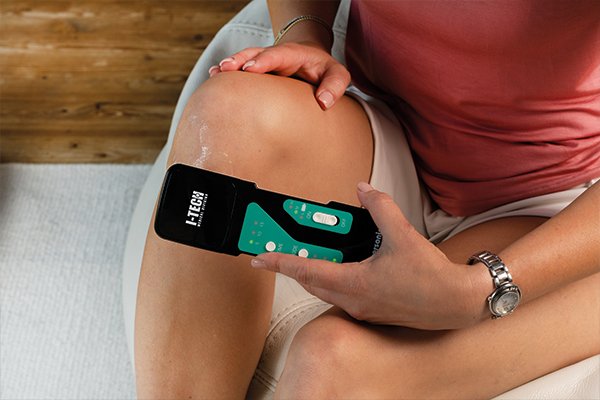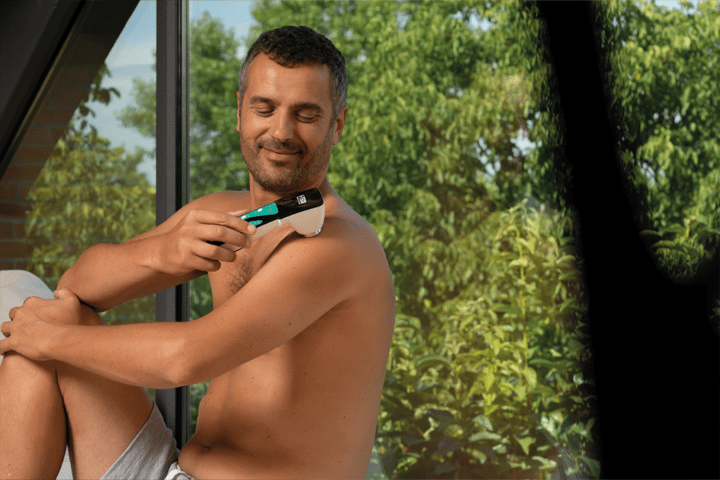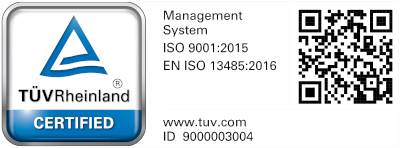Ultrasound therapy is a therapeutic technique widely used in medicine and physiotherapy to treat musculoskeletal conditions. Its analgesic and anti-inflammatory effects make it ideal for treating both subacute and chronic conditions. However, it is important to be aware of the contraindications of this therapy to ensure safe and effective treatment.
Consultation with a healthcare professional before starting therapy is essential to avoid risks and maximise benefits.
What is ultrasound therapy?
Ultrasound therapy uses high-frequency sound waves to treat various conditions. The principle of operation is based on the piezoelectric effect, where a quartz crystal or ceramic disc exposed to an alternating electric field generates mechanical vibrations. These vibrations are transmitted to the biological tissue through a conductive gel, allowing the ultrasound to penetrate to a depth of approximately 5 cm.
Ultrasound produces thermal and mechanical effects that improve microcirculation, reduce inflammation and relieve pain. They also stimulate the healing of damaged tissue and the reabsorption of haematomas. Because of these benefits, ultrasound therapy is widely used to treat musculoskeletal conditions such as tendonitis, muscle contractures and sprains.
Main contraindications to ultrasound therapy
As we have seen, ultrasound therapy is a popular therapeutic technique because of its benefits, but it is important to be aware of situations where its use may not be safe. Some specific conditions, such as the presence of tumours, the use of pacemakers and pregnancy, require special attention. Knowledge of these contraindications is essential to avoid risks and achieve the desired effects.
Ultrasound therapy is an instrumental physical therapy and as such has the same contraindications as similar therapeutic techniques.
Ultrasound and tumors
In the presence of tumours, it is advisable to consult your doctor before undergoing ultrasound therapy to assess any risks and necessary precautions.
Ultrasound and pacemaker
People using pacemakers should avoid ultrasound therapy. Ultrasound can interfere with the functioning of the pacemaker, causing malfunctions that could put the patient’s life at risk. It is essential to consult your doctor before considering this type of treatment.
Ultrasound and pregnacy
During pregnancy, ultrasound therapy is generally contraindicated. The effects of ultrasound on the fetus are not fully known, so it is prudent for pregnant women to avoid this treatment, particularly on the pelvic and abdominal area.
Other cases in which ultrasound is generally contraindicated are the following: the presence of severe arrhythmias, heart disease and serious cardiovascular problems, epilepsy, phlebitis, thrombophlebitis, febrile states, tuberculosis, neoplasms, local infections, venous thrombosis, severe osteoporosis, arteriopathy, the presence of metal implants. Children are also contraindicated to undergo treatment. In any case, it is important to consult your doctor.
Side effects of Ultrasound
Ultrasound therapy is generally a safe and effective technique. There are no known side effects, however, it is important to use it with some simple warnings. During the acute phase of a disease, for example, it is not recommended to use ultrasound because there may be redness on the skin, increased pain and swelling, which can occur especially if the therapy is used improperly.
Another aspect to keep in mind is to avoid treatment on skin lacerations or open wounds.
To limit these risks as much as possible, it is important to follow certain precautions:
Apply the head correctly: during treatment, the head of the device must adhere completely to the skin, and must be applied with light pressure, in continuous movement on the area to be treated. We advise you to read the user manual carefully before starting the session.
Use a conductive gel: a conductive gel must be applied to the skin before treatment which helps improve ultrasound transmission. Make sure it is an ultrasound therapy gel.
Adjust the intensity: check that the intensity setting is appropriate for the condition you need to treat. Always consult the device’s instructions for use and, if necessary, seek advice from a health professional.
Avoid prolonged use: limit the duration of ultrasound therapy sessions to that indicated in the user manual or as prescribed by your doctor.
Avoid using the device in hyposensitive areas: on the carotid artery, genitals, near the uterus and abdomen, in areas of the body where glands are present. Avoid treatments on the neck and mouth, as well as with direct exposure of the eye to the ultrasound beam.
Consult a professional: before starting treatment, it is essential to consult a health professional for a personalized assessment. This will help determine the appropriateness of the therapy and minimize risks.

Ultrasound in water: risks and precautions
You should know that not all ultrasound therapy devices are suitable for use in water. Some devices are specifically designed for immersion, while others are not. It is essential to check the specifications of the device and make sure it is suitable for use in water before starting therapy. Using a device that is not suitable for immersion may lead to malfunctions and increase the risk of injury.
Tips for safe use of ultrasound therapy
Ultrasound therapy is a very effective therapeutic technique, but to ensure safe use, it is essential to follow certain precautions. First of all, it is essential to consult a health professional before starting treatment. A doctor or physiotherapist can assess your specific condition and provide personalised guidance on the use of ultrasound.
When using ultrasound therapy devices, such as those of the I-Tech Medical Division brand, it is important to follow the instructions for use carefully. These devices are designed to be safe and effective, but you must use them correctly to avoid risks.

I-Tech Medical Division devices
I-Tech Medical Division devices are designed to ensure easy and safe use of ultrasound therapy, offering solutions for both home and professional use.
Powersonic and Mio-Sonic are our devices for home use, ideal for treating various musculoskeletal conditions, providing an analgesic and anti-inflammatory effect. Powersonic and Mio-Sonic are easy to use, directly by the patient, in the comfort of home.
With Powersonic you can treat muscle pain, tendonitis, sciatica, venous and pressure ulcers, carpal tunnel, arthrosis, epicondylitis, epitrocleitis and lumbar stenosis. Mio-Sonic, on the other hand, in addition to antalgic and contracture programs, also treats certain blemishes.
These devices are not suitable for immersion use.
If you need professional devices, we offer advanced solutions such as I-Tech UE and I-TECH UT2. These models are designed for both gel and immersion use, providing greater flexibility in treating different areas of the body. The professional I-Tech UE and I-TECH UT2 devices are ideal for clinics and physiotherapy centres, offering high performance and safety during use.
For more information on our products and to find the best solution for your needs, please visit our dedicated page and contact us by clicking the button below. We are here to help you get the most out of your therapy.






